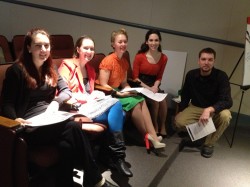Guest post by Catherine A. Brau, a Historic Preservation student at the University of Mary Washington (UMW). Our sincere thanks to Ms. Brau and the rest of the UMW and UDel students who participated in the Winter Meeting Presentations and shared their findings with us!
Barn lovers! The National Barn Alliance Meeting was hosted on campus February 15th – 17th. The National Barn Alliance is a non-profit organization committed to preserving America’s Historic barns while seeking to educate the public on efforts to preserve barns. They encourage the documentation of barns and support preservation organizations and programs. The meeting was a great opportunity to network with fellow (barn enthusiasts) preservationists and learn more about one of our more precious vernacular resources – barns. Historic barns – and farmsteads in general – are truly becoming a thing of the past as a result of commercialization and evolving technology and the poor maintenance of outdated or unnecessary structures. More importantly, barns are typically not the focus of surveying and documenting efforts.
During the conference, students were able to present their research from the Fall 2012 course Agricultural Preservation with Professor Michael Spencer. Students learned all they could about barns before being set loose to survey and document three local farmsteads – the Houseworth Barn and Arlington Carriage House at Montpelier and Flintshire Corncrib and Granary in Caroline County. These structures differ in their use and styles, and only the Houseworth barn is still functional, but all three are excellent examples of 19th century vernacular construction. Since a majority of texts concerning agricultural buildings refer to national trends, it was interesting to view what was happening on historic farmsteads at a local level (and of course was all the more important to record!). I personally hope to see this course grow in the future as it offered some great practical and networking experience and really highlighted the importance of vernacular preservation (the first barn my group was supposed to document fell over in a bad storm!). The National Barn Alliance members in attendance were excited that a younger generation is interested in continuing barn preservation and wanted to learn as much as they could about the student research and local agricultural structures.
While us students put in some hard work researching the farmsteads, we have to send a big THANK YOU out to Professor Spencer and his wife Danae for their knowledge about barns and for the networking opportunity with the National Barn Alliance. While most of us get the opportunity to be involved in some kind of research with the department, it is a rare occasion that we are able to present said research to our fellow preservationists outside of the department. These kinds of opportunities, of course, are dependent on us the students – so have fun researching and support your professors when they want you to share it with others!

